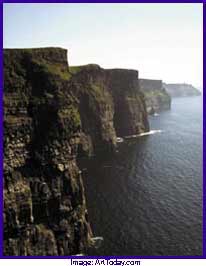A Warming Ocean

Global warming affects the Earth’s oceans and its wildlife
by Liz Olson
 Related Links
|
Scientific evidence has confirmed that carbon dioxide and other greenhouse gas emissions are harmful to Earth's atmosphere. Recent reports have found that global warming also poses a threat to the oceans.
Rising temperatures
A rise in ocean temperatures is considered one of the most harmful results of global warming. A warmer ocean could result in the loss of many fish and coral, which are vital to the ocean's ecosystem. In 2007, the surface temperature of the ocean was the highest it’s been in 30 years.
How much of the ocean is polluted?
Oceans—an important source of food and recreation for humans—cover two-thirds of Earth's surface. The Journal of Science published a report in their February 15, 2008, issue about the effect of human pollution on the ocean. According to the report, only 4% of the world’s oceans are considered pristine—meaning they are untouched by human contamination—and 40% are strongly affected by pollution. Eventually, though, even the pristine oceans, which are in the Arctic, will be contaminated by human pollution.
Oceans absorb 80% of greenhouse gases and 50% of the carbon dioxide released into the atmosphere. Over the past 50 years, as carbon dioxide emissions have increased, the ocean's temperature has steadily risen. Some negative impacts of the temperature increase include the melting of glaciers, higher sea levels, intensified storms, acidification of the ocean, and decreasing populations of marine life
Oceans become more acidic
Billions of tons of carbon dioxide are emitted into the atmosphere each year, mainly from deforestation and the burning of fossil fuels. Oceans absorb about a million tons of carbon dioxide per hour. In its natural state the ocean is alkaline, but with the absorption of too much carbon dioxide, it is becoming more acidic. Carbon dioxide forms carbonic acid when it dissolves in the water. With rising levels of carbon dioxide emissions, the ocean cannot absorb enough to keep the delicate ecosystem unharmed.
A warmer and a more acidic ocean will harm organisms at the bottom of the food chain first, such as coral and plankton, which will eventually harm the entire food chain. Scientists predict that the Ph level of the ocean will fall half a unit by 2100, making some areas of the world’s oceans, including the Southern Ocean, uninhabitable for corals. In the last 30 years, 80%-90% of coral cover in Caribbean reefs was destroyed.
The vanishing polar icecap
The greatest damage caused by warmer water can be seen in the Arctic. If the polar icecap continues to recede at its current rate, the ocean level will rise 20 feet by 2050. Scientists took a measurement of the icecap that the covers the North Pole in 1979. A 2007 measurement of the same icecap indicated it had receded 43% since 1979. Rising sea levels threaten coastal land—potentially wiping out wetlands, wildlife habitats, and destroying coastal property. Not only will melting icecaps in the Arctic cause higher sea levels, but it will also harm the population of certain animals such as polar bears, who use the ice to hunt and reproduce. Due to the vanishing sea ice, polar bears were put under the protection of the Endangered Species Act on May 15, 2008.
Storms are predicted to intensify with the warming of ocean water as well. Scientists have seen a greater number of hurricanes at higher intensity since the 1970s. Coastal land and communities especially in the Gulf of Mexico and the Caribbean will suffer from more severe storms.
What can be done to slow global warming?
Global warming cannot be reversed, but in order to slow the process, greenhouse gases have to be capped, energy consumption and the use of alternative fossil fuels reduced, and deforestation must be curtailed.
Source: www.oceanconservancy.org
- More from Environment







